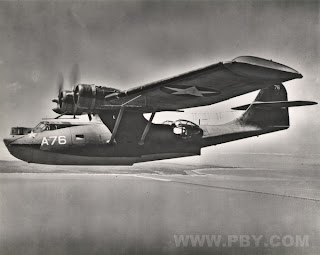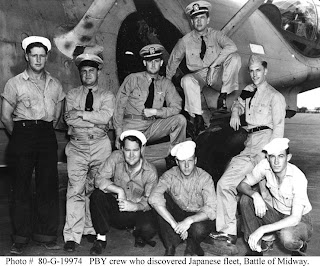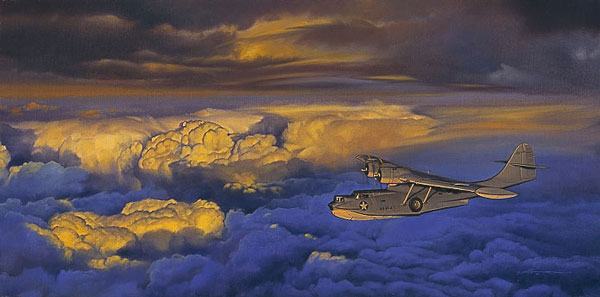Flightdeck Friday: Countdown to Midway – Land-based Air (US)
Beginning with Billy Mitchell’s “demonstration†off VACAPES in 1921 where the Ostfriesland and ex-USS Alabama were sunk by heavy bombers, airpower proponents hailed the ability of land-based aircraft to protect our coastlines, claiming precision bombing would make surface ships obsolete. Now, in the wake of the attack by Japanese carrier-based aircraft on Pearl Harbor and the subsequent all out offensive through out the western reaches of the Pacific, land-based air began staging at Midway and would soon have the chance to prove if the advertising was true or not.
Onboard Midway, a collection of aircraft ranging from Marine fighters (F2A Buffalos and F4F Wildcats) and dive bombers (SBD Dauntless’s and SB2U-3 Vindicators) to Navy PBY Catalina’s and TBF-1 Avengers were joined by elements of the 7th Air Force, contributing 17 of America’s frontline bomber, the B-17E Flying Fortress and 4 of the new Martin B-26 Marauders. The former would conduct long range patrols in concert with the Navy PBYs to locate Japanese forces and attack same from high altitude while the Marauders would be used for low-level attacks with airborne torpedoes.
(Ed note: Because of the ranges involved, Japanese land-based air was not a factor. Since the Marine and Navy fighters and bombers had counterparts on the carriers, they will be covered in next week’s installment which centers on ship-based air. – SJS)
The PBY Catalina
Ubiquitous, jack-of-all trades, vital, lifesaver. Many adjectives came to describe the PBY Catalina, perhaps the widest produced and used seaplane of record. Designed with the extreme distances of the Pacific and the rise of a potential rival, Japan, in mind, the PBY (PB – Patrol Bomber, Y-Consolidated Aircraft) first flew on 28 March 1935 as the XP3Y-1 (it later would be changed to PBY) – the final construction figure is estimated at around 4,000 aircraft, and these were deployed in practically all of the operational theaters of World War II.
 While the Catalina would see extensive service as an ASW aircraft, night attack and SAR, its most famous missions were as a long range patrol aircraft – first locating the German pocket battleship Bismarck and later at Midway, making the initial sighting of the Japanese fleet bound for Midway. Thirty-one PBY-5s from Patrol Wings 1 and 2 (under Captain Cyril Simmard, USN) were onboard Midway serving this mission and providing SAR capabilities as a secondary function.
While the Catalina would see extensive service as an ASW aircraft, night attack and SAR, its most famous missions were as a long range patrol aircraft – first locating the German pocket battleship Bismarck and later at Midway, making the initial sighting of the Japanese fleet bound for Midway. Thirty-one PBY-5s from Patrol Wings 1 and 2 (under Captain Cyril Simmard, USN) were onboard Midway serving this mission and providing SAR capabilities as a secondary function.
The B-17E Flying Fortress
On 8 August 1934, the U.S. Army Air Corps (USAAC) tendered a proposal for a multi-engined bomber to replace the Martin B-10. Requirements were that it would carry a “useful bomb load” at an altitude of 10,000 feet for ten hours with a top speed of at least 200 mph. Also desired were a range of 2,000 miles and a speed of 250 mph. The Air Corps were looking for a bomber capable of reinforcing the air forces in Hawaii, Panama, and Alaska. The competition would be decided by a “fly-off” at Wright Field in Dayton, Ohio. Boeing competed with the Douglas DB-1 and Martin Model 146 for the Air Corps contract.
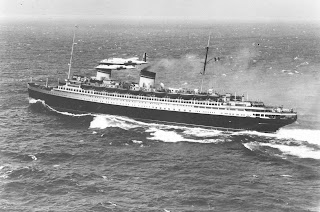 On 1 March 1937, 12 of the 13 YB-17s were delivered to the 2nd Bombardment Group at Langley Field in Virginia, and used to help develop heavy bomber techniques and work out other bugs. In one of their first missions, three B-17s, following lead navigator Lt. Curtis LeMay, were sent by General Andrews to “intercept” the Italian ocean liner Rex 800 miles off the Atlantic coast and take photographs. The successful mission was widely publicized.
On 1 March 1937, 12 of the 13 YB-17s were delivered to the 2nd Bombardment Group at Langley Field in Virginia, and used to help develop heavy bomber techniques and work out other bugs. In one of their first missions, three B-17s, following lead navigator Lt. Curtis LeMay, were sent by General Andrews to “intercept” the Italian ocean liner Rex 800 miles off the Atlantic coast and take photographs. The successful mission was widely publicized.
In late 1937 the Air Corps ordered ten more planes, designated B-17B and, soon after, another 29. Improved with larger flaps, rudder and Plexiglas nose, the B-17Bs were delivered between July 1939 and March 1940. They equipped two bombardment groups, one on each US coast. Prior to the attack on Pearl Harbor, fewer than 200 B-17s were in service with the Army, but production quickly accelerated, and the B-17 became the first truly mass-produced large  aircraft. The aircraft went on to serve in every World War II combat zone, and by the time production ended in May 1945, 12,731 aircraft had been built by Boeing, Douglas and Vega (a subsidiary of Lockheed).
aircraft. The aircraft went on to serve in every World War II combat zone, and by the time production ended in May 1945, 12,731 aircraft had been built by Boeing, Douglas and Vega (a subsidiary of Lockheed).
The B-17E variants at Midway were an extensive redesign of that used in previous models up to the B-17D. The most obvious change was the vertical stabilizer, resulting in a shape that was distinctive for the time.
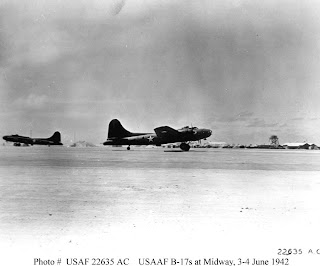 Because experience had shown that the plane would be vulnerable to attack from behind, a tail gunner and powered two gun turret behind the cockpit were added to the B-17E design. (Before this, crews had to devise elaborate maneuvers, to deal with a direct attack from behind, including jerking the aircraft laterally, allowing the waist gunners to alternate shots at it.) The configuration with 3-window box would also appear on the B-29, and also adopted by Soviet bombers as late as the Tupolev Tu-16 Badger, and in different form on the B-52. The teardrop-shaped sliding panels of the waist gunners were replaced by larger rectangular windows for better visibility. In the initial fifth of the production run, the ventral bathtub turret was replaced by a remote-sighted Bendix turret. Aircraft built after that used a Sperry ball turret. A total of 512 were built, making the B-17E the first mass-produced version of the B-17. The B-17E’s at Midway were under the command of Lt. Col. Walter C. Sweeney, USA and were assigned to the 7th Air Force.
Because experience had shown that the plane would be vulnerable to attack from behind, a tail gunner and powered two gun turret behind the cockpit were added to the B-17E design. (Before this, crews had to devise elaborate maneuvers, to deal with a direct attack from behind, including jerking the aircraft laterally, allowing the waist gunners to alternate shots at it.) The configuration with 3-window box would also appear on the B-29, and also adopted by Soviet bombers as late as the Tupolev Tu-16 Badger, and in different form on the B-52. The teardrop-shaped sliding panels of the waist gunners were replaced by larger rectangular windows for better visibility. In the initial fifth of the production run, the ventral bathtub turret was replaced by a remote-sighted Bendix turret. Aircraft built after that used a Sperry ball turret. A total of 512 were built, making the B-17E the first mass-produced version of the B-17. The B-17E’s at Midway were under the command of Lt. Col. Walter C. Sweeney, USA and were assigned to the 7th Air Force.
The Martin B-26 Marauder
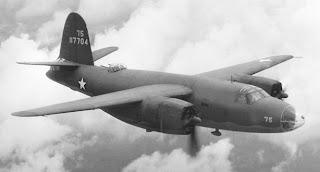 In 1939, the United States Army Air Corps issued a specification for a twin-engined medium bomber, Circular Proposal 39-640. Six months later, Glenn L. Martin Company presented a design to the Air Corps. Peyton M. Magruder led the design team for this aircraft after Martin won the contract. This design, Martin Model 179, was accepted for production before a prototype even flew, due to the desperate need for medium bombers following the intensification of the war in Europe.
In 1939, the United States Army Air Corps issued a specification for a twin-engined medium bomber, Circular Proposal 39-640. Six months later, Glenn L. Martin Company presented a design to the Air Corps. Peyton M. Magruder led the design team for this aircraft after Martin won the contract. This design, Martin Model 179, was accepted for production before a prototype even flew, due to the desperate need for medium bombers following the intensification of the war in Europe.
Once the first aircraft came off the production line in November 1940, Martin conducted tests, the results of which were promising. The first B-26 with Martin test pilot William K. “Ken” Ebel at the controls, flew on 25 November 1940 and was effectively the prototype. Soon after, it was turned over to the Army Air Corps to be service tested. It went from paper concept to working plane in less than two years.
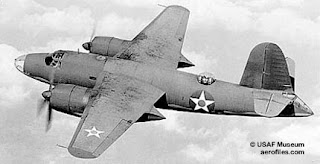 While the B-26 was a fast plane with better performance than the contemporary B-25 Mitchell, its relatively small wing area and resulting high wing loading (the highest of any aircraft used at that time) led to tricky high-speed landings (approach at 140 mph (225 km/h) and stall at 130 mph (210 km/h) indicated airspeed). The R-2800 engines were reliable but the electric pitch change mechanism in the propellers required impeccable maintenance and was prone to failure. Failure of the mechanism placed the propeller blades in flat pitch with instant total loss of power. Due to the rotund fuselage, the B-26 engines were placed far outboard and loss of power on one side resulted in a violent snap roll flipping the aircraft on its back. This led to a high number of accidents during takeoff, thus earning B-26 the nickname “Widowmaker” by its pilots (other colorful nicknames included “Martin Murderer,” “The Flying Coffin,” “B-Dash-Crash,” “The Flying Prostitute,” (because it had no visible means of support, referring to the small wings) and “The Baltimore Whore” (because the Martin Company was located there).
While the B-26 was a fast plane with better performance than the contemporary B-25 Mitchell, its relatively small wing area and resulting high wing loading (the highest of any aircraft used at that time) led to tricky high-speed landings (approach at 140 mph (225 km/h) and stall at 130 mph (210 km/h) indicated airspeed). The R-2800 engines were reliable but the electric pitch change mechanism in the propellers required impeccable maintenance and was prone to failure. Failure of the mechanism placed the propeller blades in flat pitch with instant total loss of power. Due to the rotund fuselage, the B-26 engines were placed far outboard and loss of power on one side resulted in a violent snap roll flipping the aircraft on its back. This led to a high number of accidents during takeoff, thus earning B-26 the nickname “Widowmaker” by its pilots (other colorful nicknames included “Martin Murderer,” “The Flying Coffin,” “B-Dash-Crash,” “The Flying Prostitute,” (because it had no visible means of support, referring to the small wings) and “The Baltimore Whore” (because the Martin Company was located there).
The toll eventually led to a halt in production. During this time a commission of inquiry (led by then-Senator Harry Truman) was appointed to look into the problem. When Truman and the other commission members arrived at the Avon Park Bombing Range, they were greeted by the still-burning wreckage of two crashed Marauders. Indeed, the regularity of crashes by  pilots training at MacDill Field — up to fifteen in one thirty day period — led to the only mildly exaggerated catchphrase, “One a day in Tampa Bay.”
pilots training at MacDill Field — up to fifteen in one thirty day period — led to the only mildly exaggerated catchphrase, “One a day in Tampa Bay.”

